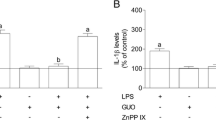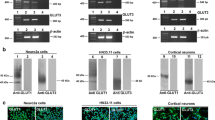Abstract
Gadolinium (Gd) and its complexes are utilized widely in industrial and clinical diagnoses. As a rare earth metal ion, free gadolinium (Gd3+) in the human body poses neurotoxic risks during its in vivo release and retention. In the central nervous system, astrocytes play a pivotal role in processing toxic metal ions. The present study evaluates the effects of Gd on cellular calcium homeostasis, a common mechanism that causes cell death, and on unfolded protein responses (UPRs), a mechanism for cell survival in response to toxic stimuli in mammalian cells. The experimental results indicate that the influx of extracellular Ca2+ increases greatly after the exposure of astrocytes to Gd; however, no cell deaths were observed. Further evidence suggests the up-regulated expression of the endoplasmic reticulum (ER)-resident chaperone protein GRP78 by ER stress-mediated signal transductions, specifically the activation of ATF6, eIF2a, and IRE1. These results suggest that Gd promotes Ca2+ influx, thus triggering UPRs, which can be closely associated to the resistance of astrocytes to Gd-induced cytotoxicity.







Similar content being viewed by others
References
Abramov AY, Canevari L, Duchen MR. Changes in intracellular calcium and glutathione in astrocytes as the primary mechanism of amyloid neurotoxicity. J Neurosci. 2003;23(12):5088–95.
Aoyama K, Burns DM, Suh SW, Garnier P, Matsumori Y, Shiina H, et al. Acidosis causes endoplasmic reticulum stress and caspase-12-mediated astrocyte death. J Cereb Blood Flow Metab. 2005;25(3):358–70.
Benavides A, Pastor D, Santos P, Tranque P, Calvo S. CHOP plays a pivotal role in the astrocyte death induced by oxygen and glucose deprivation. Glia. 2005;52:261–75.
Broome DR. Nephrogenic systemic fibrosis associated with gadolinium based contrast agents: a summary of the medical literature reporting. Eur J Radiol. 2008;66:230–4.
Burdakov D, Petersen OH, Verkhratsky A. Intraluminal calcium as a primary regulator of endoplasmic reticulum function. Cell Calcium. 2005;38(3–4):303–10.
Chandra S, Kable EP, Morrison GH, Webb WW. Calcium sequestration in the Golgi apparatus of cultured mammalian cells revealed by laser scanning confocal microscopy and ion microscopy. J Cell Sci. 1991;100(4):747–52.
Chen C-J, Liao S-L. Oxidative stress involves in astrocytic alterations induced by manganese. Exp Neurol. 2002;175(1):216–25.
Diamond JS. Astrocytes put down the broom and pick up the baton. Cell. 2006;125(4):639–41.
Dong S, Zhao Y, Liu H, Yang X, Wang K. Duality of effect of La3+ on mitochondrial permeability transition pore depending on the concentration. Biometals. 2009;22:917–26.
Erikson KM, Dobson AW, Dorman DC, Aschner M. Manganese exposure and induced oxidative stress in the rat brain. Sci Total Environ. 2004;334(335):409–16.
Feng L, Xiao H, He X, Li Z, Li F, Liu N, et al. Neurotoxicological consequence of long-term exposure to lanthanum. Toxicol Lett. 2006;165(2):112–20.
Gunter TE, Gunter KK, Sheu SS, Gavin CE. Mitochondrial calcium transport: physiological and pathological relevance. Am J Physiol Cell Physiol. 1994;267(2):C313–39.
Halaszovich CR, Zitt C, Jüngling E, Lückhoff A. Inhibition of TRP3 channels by lanthanides: block from the cytosolic side of the plasma membrane. J Biol Chem. 2000;275:37423–8.
Hayashi T, Saito A, Okuno S, Ferrand-Drake M, Dodd RL, Chan PH. Damage to the endoplasmic reticulum and activation of apoptotic machinery by oxidative stress in ischemic neurons. J Cereb Blood Flow Metab. 2005;25(1):41–53.
Jung S, Mühle A, Schaefer M, Strotmann R, Schultz G, Plant TD. Lanthanides potentiate TRPC5 currents by an action at extracellular sites close to the pore mouth. J Biol Chem. 2003;278:3562–71.
Kondo S, Murakami T, Tatsumi K, Ogata M, Kanemoto S, Otori K, et al. OASIS, a CREB/ATF-family member, modulates UPR signalling in astrocytes. Nat Cell Biol. 2005;7(2):186–98.
Kudo T, Kanemoto S, Hara H, Morimoto N, Morihara T, Kimura R, et al. A molecular chaperone inducer protects neurons from ER stress. Cell Death Differ. 2008;15:364–75.
Lai E, Teodoro T, Volchuk A. Endoplasmic reticulum stress: signaling the unfolded protein response. Physiol Rev. 2007;22(3):193–201.
Lansman JB. Blockade of current through single calcium channels by trivalent lanthanide cations. Effect of ionic radius on the rates of ion entry and exit. J Gen Physiol. 1990;95(4):679–96.
Legare ME, Barhoumi R, Hebert E, Bratton GR, Burghardt RC, Tiffany-Castiglioni E. Analysis of Pb2+ entry into cultured astroglia. Toxicol Sci. 1998;46(1):90–100.
Li XA, Lee AS. Competitive inhibition of a set of endoplasmic reticulum protein genes (GRP78, GRP94, and ERp72) retards cell growth and lowers viability after ionophore treatment. Mol Cell Biol. 1991;11(7):3446–53.
Lin AMY, Chao PL, Fang SF, Chi CW, Yang CH. Endoplasmic reticulum stress is involved in arsenite-induced oxidative injury in rat brain. Toxicol Appl Pharmacol. 2007;224(2):138–46.
Lindholm D, Wootz H, Korhonen L. ER stress and neurodegenerative diseases. Cell Death Differ. 2006;13:385–92.
Liu H, Hu J, Liu X, Li R, Wang K. Effects of lanthanide ions on hydrolysis of phosphatidylinositol in human erythrocyte membranes. Chinese Sci Bull. 2001;46:401–3.
Lutz TA, Rossi R, Althaus J, Del Prete E, Scharrer E. Amylin reduces food intake more potently than calcitonin gene-related peptide (CGRP) when injected into the lateral brain ventricle in rats. Peptides. 1998;19(9):1533–40.
Maragakis NJ, Rothstein JD. Mechanisms of Disease: astrocytes in neurodegenerative disease. Nat Clin Pract Neuro. 2006;2(12):679–89.
Marciniak SJ, Ron D. Endoplasmic reticulum stress signaling in disease. Physiol Rev. 2006;86:1133–49.
Michalak M, Robert Parker JM, Opas M. Ca2+ signaling and calcium binding chaperones of the endoplasmic reticulum. Cell Calcium. 2002;32(5–6):269–78.
Mlinar B, Enyeart JJ. Block of current through T-type calcium channels by trivalent metal cations and nickel in neural rat and human cells. J Physiol. 1993;469(1):639–52.
Murakami T, Kondo S, Ogata M, Kanemoto S, Saito A, Wanaka A, et al. Cleavage of the membrane-bound transcription factor OASIS in response to endoplasmic reticulum stress. J Neurochem. 2006;96:1090–100.
Qian Y, Harris ED, Zheng Y, Tiffany-Castiglioni E. Lead targets GRP78, a molecular chaperone, in C6 rat glioma cells. Toxicol App Pharmacol. 2000;163(3):260–6.
Qian Y, Tiffany-Castiglioni E. Lead-induced endoplasmic reticulum (ER) stress responses in the nervous system. Neurochem Res. 2003;28(1):153–62.
Qian Y, Zheng Y, Ramos KS, Tiffany-Castiglioni E. GRP78 compartmentalized redistribution in Pb-treated glia: role of GRP78 in lead-induced oxidative stress. Neurotoxicology. 2005;26:267–75.
Rao RV, Ellerby HM, Bredesen DE. Coupling endoplasmic reticulum stress to the cell death program. Cell Death Differ. 2004;11:372–80.
Saito A, Hino SI, Murkami T, Kondo S, Imaizumi K. A novel ER stress transducer, OASIS, expressed in astrocytes. Antioxid Redox Signal. 2007;9(5):563–71.
Shanker G, Aschner M. Methylmercury-induced reactive oxygen species formation in neonatal cerebral astrocytic cultures is attenuated by antioxidants. Mol Brain Res. 2003;110:85–91.
Shao-Pow L, Jeffrey JB. MR contrast agents: physical and pharmacologic basics. J Magn Reson Imag. 2007;25(5):884–99.
Shen C, Li Z, Yang X, Wang K. La3+ binds to BiP/GRP78 and induces unfolded protein response in HepG2 cells. Chem Biol Interact. 2008;176(2–3):196–203.
Smith MI, Deshmukh M. Endoplasmic reticulum stress-induced apoptosis requires bax for commitment and Apaf-1 for execution in primary neurons. Cell Death Differ. 2007;14:1011–9.
Tajiri S, Oyadomari S, Yano S, Morioka M, Gotoh T, Hamada JI, et al. Ischemia-induced neuronal cell death is mediated by the endoplasmic reticulum stress pathway involving CHOP. Cell Death Differ. 2004;11:403–15.
Toney GM, Chavez HA, Ibarra R. Acute and subacute physiological and histological studies of the central nervous system after intrathecal gadolinium injection in the anesthetized rat. Invest Radiol. 2001;36:33–40.
Trebak M, Bird GSJ, McKay RR, James W, Putney J. Comparison of human TRPC3 channels in receptor-activated and store-operated modes: differential sensitivity to channel blockers suggests fundamental differences in channel composition. J Biol Chem. 2002;277:21617–23.
Verkhratsky A. Physiology and pathophysiology of the calcium store in the endoplasmic reticulum of neurons. Physiol Rev. 2005;85:201–79.
Werth JL, Thayer SA. Mitochondria buffer physiological calcium loads in cultured rat dorsal root ganglion neurons. J Neurosci. 1994;14(1):348–56.
Xiao H, Li F, Zhang Z, Feng L, Li Z, Yang J, et al. Distribution of ytterbium-169 in rat brain after intravenous injection. Toxicol Lett. 2005;155:247–52.
Yang J, Liu Q, Zhang L, Wu S, Qi M, Lu S, et al. Lanthanum chloride impairs memory, decreases pCaMK IV, pMAPK and pCREB expression of hippocampus in rats. Toxicol Lett. 2009;190(2):208–14.
Yu S, Hu J, Yang X, Wang K, Qian ZM. La3+-induced extracellular signal-regulated kinase (ERK) signaling via a metal-sensing mechanism linking proliferation and apoptosis in NIH 3T3 cells. Biochemistry. 2006;45(37):11217–25.
Yu Z, Luo H, Fu W, Mattson MP. The endoplasmic reticulum stress-responsive protein GRP78 protects neurons against excitotoxicity and apoptosis: suppression of oxidative stress and stabilization of calcium homeostasis. Exp Neurol. 1999;155:302–14.
Zha X, Chandra S, Ridsdale AJ, Morrison GH. Golgi apparatus is involved in intracellular Ca2+ regulation in epithelial LLC-PK1 cells. Am J Physiol Cell Physiol. 1995;268(5):C1133–40.
Acknowledgments
This work was supported by the NNSFC (Grant Nos. 20901005 and 20637010) and the Research Fund for the Doctoral Program of Higher Education (No. 200800011056).
Author information
Authors and Affiliations
Corresponding authors
Additional information
Xu-Dong Feng and Qing Xia contribute equally to this paper.
Rights and permissions
About this article
Cite this article
Feng, XD., Xia, Q., Yuan, L. et al. Gadolinium triggers unfolded protein responses (UPRs) in primary cultured rat cortical astrocytes via promotion of an influx of extracellular Ca2+ . Cell Biol Toxicol 27, 1–12 (2011). https://doi.org/10.1007/s10565-010-9166-2
Received:
Accepted:
Published:
Issue Date:
DOI: https://doi.org/10.1007/s10565-010-9166-2




